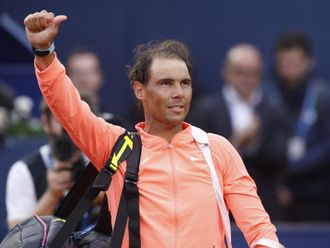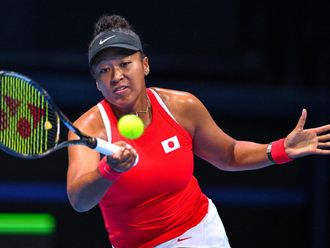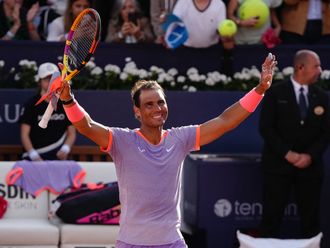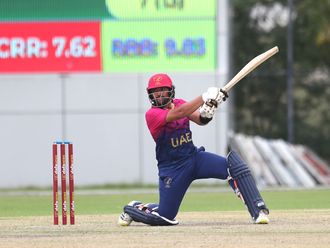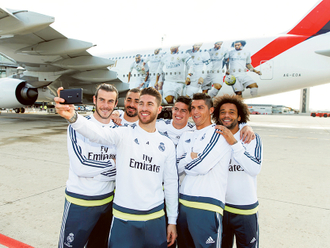London: Magnus Norman is the world’s best tennis coach. So the theory goes, in locker-rooms from Melbourne to Madrid.
And after spending a revelatory half-hour on the practice court with him last week, I am not inclined to quibble. Seven days ago in Paris, Norman was preparing his client Stan Wawrinka to face Rafael Nadal in a grand slam final. On Friday, he faced an even greater challenge: fixing my wonky backhand.
In his whispery Swedish mumble, Norman recommended earlier preparation, a looser grip and the same flick of the wrist you might use to deliver a Frisbee. After just a couple of attempts, I could hear a new and brighter note in the (formerly soggy) sound of ball on strings. “Repetition is important for most of us,” said Norman, after cajoling me into another personal best: a first serve that flew down the ‘T’ at something greater than mobility-scooter pace.
“Wake Rafa up in the night and he can hit a forehand because he has done it so many times. It’s different with Roger [Federer]: he just has magic in his hands, so he practises in a less structured way. As a coach, you have to adapt to your player.”
There is something very Scandinavian in Norman’s humility and understatement. His coaching philosophy is unflashy, relying on painstaking drills. “This is one I use a lot with Stan,” he explained, pulling up a bucket of balls. “A deep backhand, then a shorter forehand kill. It’s about quick feet, early set-up and balance.”
The classic amateur error here is to forget to take your own momentum into account, thus sending your forehand screaming over the baseline. But Wawrinka is a master of this delicate physical calculus. When he puts a ball away, it isn’t coming back. “People say I changed Stan’s forehand,” Norman admitted, “but I wouldn’t go that far. What we worked on was to play a little bit safer. Higher over the net, more shape, and not so close to the lines. Because Stan’s problem maybe when he is not confident he is over-firing a little bit.
“I don’t think I am the best coach in the world. I see myself more as a generalist, I know a little bit about tennis [he did reach No. 2 in the world as a player] but I also know a little bit about nutrition, health, technique, tactics, fitness. I blend everything together. But most of it is in the head.”
If there is a newfound steadiness to Wawrinka’s tennis, this owes much to Norman’s no-stone-unturned approach. When they combined for a first, exploratory training session in 2013, Wawrinka said it was the toughest he had ever experienced. Norman replied that he was only getting started.
Sitting on the sun-drenched Queen’s Club balcony, I asked him whether he had always sensed greatness lurking in Wawrinka’s bear-like frame. “Actually no,” Norman replied, “I don’t think either of us ever thought we would be winning grand slam tournaments. But I felt like Stan was a great guy, a good personality. I knew he had potential because I was coaching against him a few times.”
Allowing himself one small moment of pride, Norman added: “I think Stan said it best himself. When he was asked what I brought to his tennis, he said, ‘Magnus made me a winner’. But it was a lot of luck as well, of course. He had put in many years of hard work and then maybe I came in and said a few things that worked.”
If the transformation was not quite as instant as my backhand epiphany, it was not far off. When they came together in April 2013, Wawrinka was ranked No. 17 and perceived as something of a wastrel. Within nine months, he had beaten both Novak Djokovic and Nadal in best-of-five-set matches at the same slam — an almost unheard-of achievement — to seize his first major title in Melbourne.
Results have ebbed and flowed since, yet Wawrinka has never dropped out of the world’s top 10. “One of the things we spoke about is to try to have a more stable level throughout the year,” says Norman.
“He can beat anybody, but you never know with Stan. Sometimes it looks from the outside that he doesn’t care. But he’s nervous when he’s acting like that, he wants it too much. At least, that’s what he’s saying to me.
“Before Geneva this year, he struggled on the claycourts. So we lay everything on the table and decide how we were going to work for the next few weeks. It turned out to be a good meeting and he did really well.”
Quite so: Wawrinka responded with 10 straight victories over 14 days, a list of scalps that culminated in a five-set win over Andy Murray in the French Open semi-final. But Court Philippe Chatrier is Nadal’s manor, and this proved a final too far.
“I felt from the beginning, ‘Oof, it’s going be really tough’,” said Norman. “Rafa had an aura around him. I’ve never seen him hit his backhand as well as he did in the final, moving it cross-court to down-the-line, and also with a lot of speed. And then he had the looping forehand to high on Stan’s backhand.
“For sure, Rafa is playing better now than 10 years ago. And the same with Roger. You look at pictures from then and they play further back, they play slower. When I played, five years before that, we were also hitting the ball quite hard, but now they’re moving better, taking the ball early. That’s the evolution of the game.”
An evolution that Norman himself, as much as any of the higher-profile “supercoaches”, has done a great deal to enable.
The Aegon Championships start Monday at the Queen’s Club, with Andy Murray and Stan Wawrinka as the top two seeds.
— The Telegraph Group Limited, London 2017


